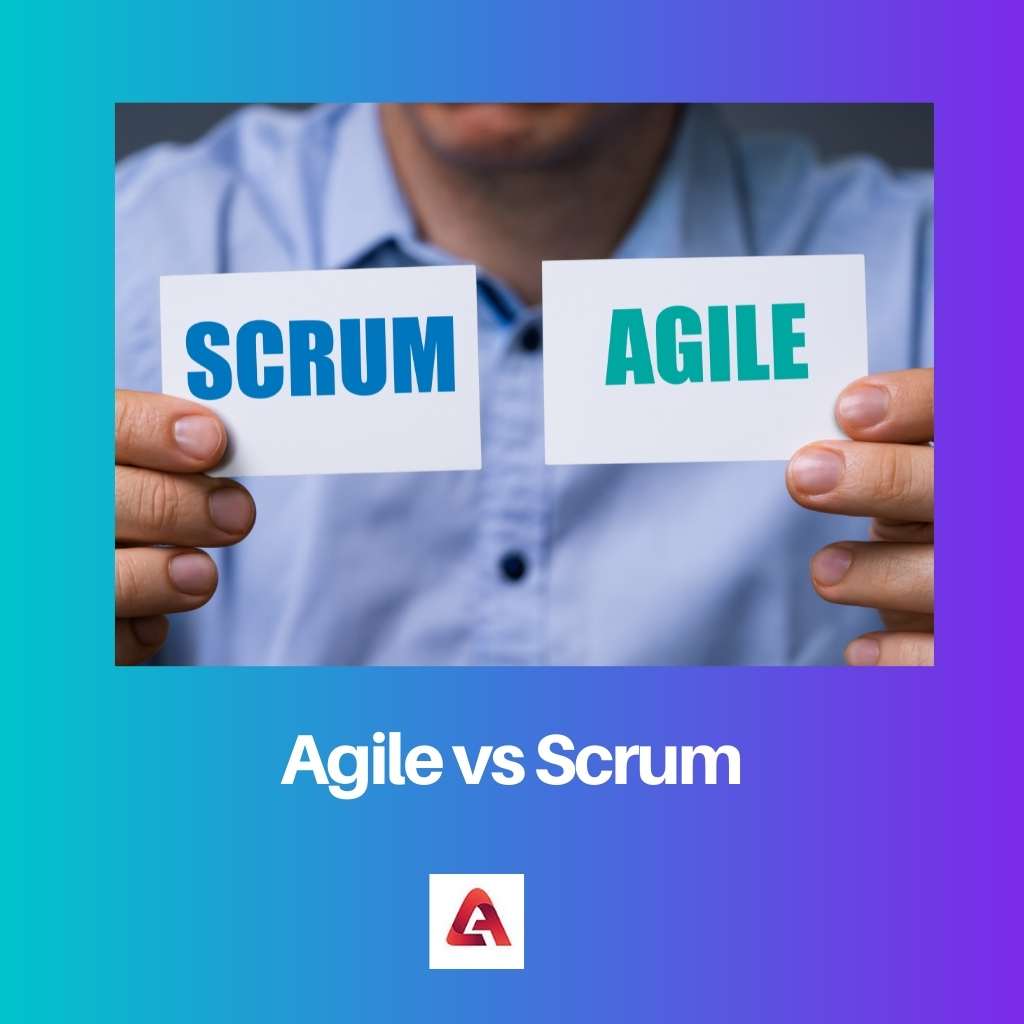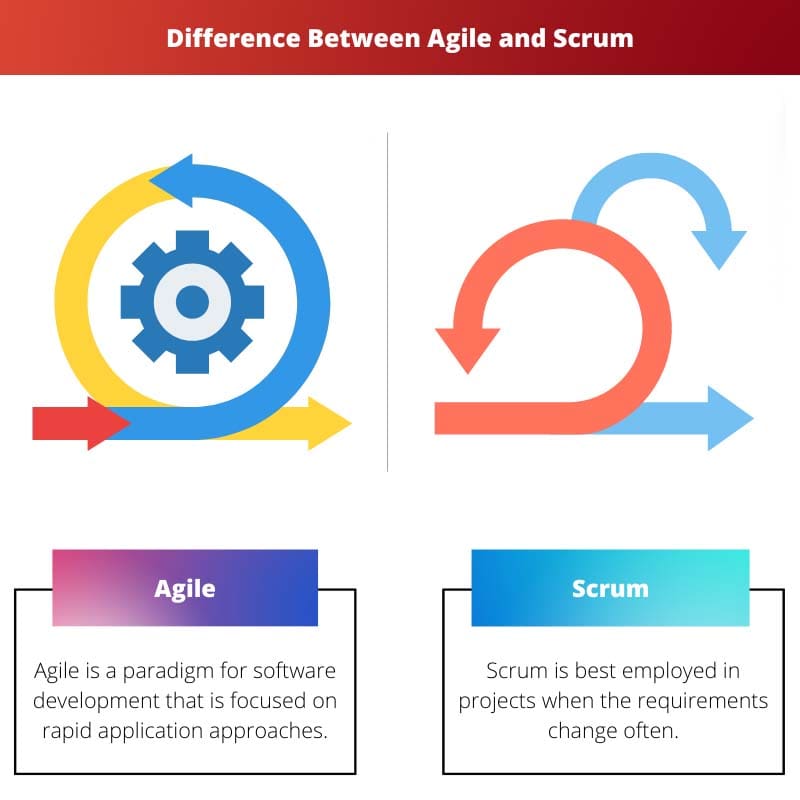There are several techniques to select from, each of which is appropriate to specific projects.
Agile and Scrum are two of the most popular and sometimes misunderstood techniques in project management.
Task managers are in charge of developing an appropriate project schedule for the activities they supervise. They are in charge of identifying and managing risks linked with their initiatives.
It is critical to select the correct project management approach to lead your endeavours and bring your venture to a conclusion.
Key Takeaways
- Agile is a project management philosophy emphasizing adaptability and continuous improvement, while Scrum is a specific framework implementing Agile principles.
- Scrum uses defined roles, events, and artifacts to promote collaboration and efficient workflow in development projects.
- Agile can be applied to various industries and projects, while Scrum is best suited for software development and product management.
Agile vs Scrum
Agile is a set of values and principles for software development. Scrum is a specific Agile framework that provides a set of rules and practices for managing and completing projects. Agile is more general, while Scrum is more detailed and focused on software development projects.

Agile is a project managerial strategy or mindset that strives to accomplish a purpose in short iterations.
An Agile project, regardless of a single colossal reveal or presentation, consists of smaller segments of activities that may be continually performed in shorter time constraints.
This simplifies project crews to accommodate shifting priorities, address emerging problems, and save money, time, and energy.
To implement Agile ideas in a firm or initiative, you should employ a specific paradigm.
Scrum is a commercial development process intended for use in a fluid setting. Supply cycles are referred to as “sprints” in Scrum, and they run one to four weekends.
Scrum squads are primarily compact, varying from three to nine persons, including a Scrum master and a brand proprietor.
Collaboration with team colleagues and stakeholders is frequent, allowing for coherent evaluation and modifications.
Comparison Table
| Parameters of Comparison | Agile | Scrum |
|---|---|---|
| Meaning | Scrum’s most significant benefit is its adaptability since it responds fast to changes. | Scrum is one of the methodology’s implementations where significant upgrades are supplied to customers periodically for two to three weeks. |
| Used in | Agile software development is regarded as best appropriate to situations with a unique and highly skilled developing team. | Scrum is best employed in projects when the requirements change often. |
| Nature | It is a stricter technique than Scrum. As a result, there isn’t much room for regular modifications. | In the agile technique, the project manager oversees all responsibilities. |
| Adjustments | Agile development methodologies and organizational transformation can be time-consuming in the beginning. | When applying the scrum method, not many adjustments are required. |
| Leader | Because there is no team leader, the entire roster addresses the difficulties or conflicts. | Because there is no team leader, the difficulties or conflicts are addressed by the entire roster. |
What is Agile?
An agile project administrator is a venture ideology or methodology employing an iterative project accomplishment approach.
According to the Project Management Organization, the Agile approach aims to provide immediate, quantifiable ROI through specified, incremental delivery of value propositions.
Because Agile techniques are iterative, continual customer participation is required to confirm that objectives are matched and permit the project coordinator to adjust to modifications throughout the workflow.
Agile is a program management concept based on core ideas and concepts. Consider Agile broadly as a guiding viewpoint for undertaking project activities.
An Agile process’s core ideas and concepts may be implemented across multiple specialized approaches.
Agile teams include individuals from a variety of cross-functional organizations.
After the project, everything is provided in an agile manner.
For example, if you manage your projects using an Agile methodology, you’ll choose to have frequent contact well with clients and end-users; you’re pledged towards a more open concept of perspective that may develop depending on input from end-users.
Agile originated in programming development but is currently utilized in various sectors, encompassing technology, marketing, architecture, and money.
Many sectors, like engineering that have traditionally depended on conventional project management approaches have begun to adopt Agile practices into overall operations.

What is Scrum?
Scrum project management is a prominent Agile methodology among project supervisors. Scrum is a unique project management approach.
It outlines how to determine the task, who will perform it, how it will be performed, and when it will be accomplished.
The project leader directs the administration team in Scrum program management and comprises a business proprietor, Scrum Master, and additional cross-functional unit contributors.
The product manager is in charge of increasing the relevance of the item, while the Scrum Master is in order to verify that the development team adheres to the Scrum process.
This activity ought to be accessible to hand over to the customer after the sprint.
The sprint concludes with a sprint evaluation and assessment. This cycle is continued across the project duration unless the whole scope of work is completed.
This resembles characteristics of classical project management in significant respects.
It enables the customer to recognize the worth of the project during the workflow rather than waiting until the project is completed.
A scrum is an Agile approach. It is divided into smaller sprints with smaller milestones.
Specific positions on the scrum project team comprise the Scrum Master and Responsible Person.
Main Differences Between Agile and Scrum
- Scrum is a Framework process that focuses on conveying business significance quickly. Agile is an ongoing version of verification and validation in the software development process.
- The agile technique distributes software frequently for review, whereas Scrum distributes material after each session.
- Leadership is essential in the Agile methodology, whereas Scrum supports a self-organizing, cross-functional workforce.
- Agile cooperation entails face-to-face contacts involving representatives of particular cross-functional teams, whereas Scrum cooperation is accomplished through frequent stand-up conferences.
- Innovation and implementation in the Agile process should be preserved uncomplicated, but innovation and implementation in the Scrum methodology can be original and exploratory.

I found this article to be very engaging.
This article is comical. The author made the information humorous and less serious.
I respectfully disagree with Elliott. I think the information was presented in a scholarly and professional manner.
I think this article is somewhat substantial and detailed, yet it does not provide enough practical examples.
This article provides a great deal of valuable information with regard to project management. The examples are insightful and accurate.
I agree with you Theresa. This is a very well-written article.
I’d argue that it was too in-depth and therefore difficult to follow.
I found the article to be highly informative and I believe it’s a great resource for those looking to further their understanding of project management principles.
I agree with Wayne. I think the article is beneficial for anyone learning about Agile and Scrum.
I believe there were some gaps in the explanation. It could have been explained in a more comprehensive manner.